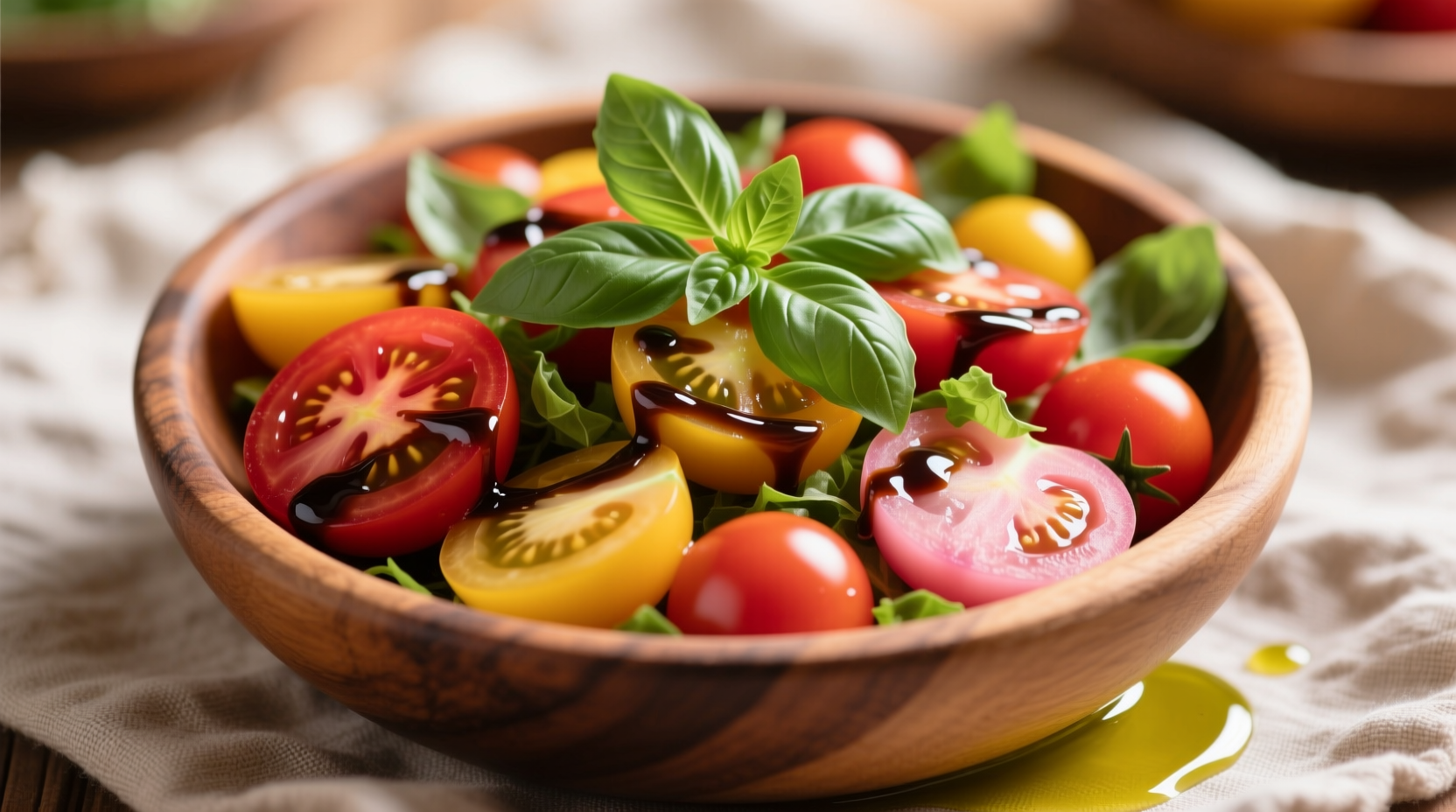Why This Simple Salad Deserves a Spot on Your Table
When crafted with care, a balsamic tomato salad transforms humble ingredients into something extraordinary. Unlike complicated recipes requiring special equipment, this dish showcases how minimal intervention often yields maximum flavor. The magic happens when quality balsamic vinegar interacts with perfectly ripe tomatoes—the vinegar's complex sweetness balances the tomatoes' natural acidity, while its rich umami notes deepen the overall flavor profile.
Professional chefs consistently return to this preparation because it requires no cooking and adapts beautifully to seasonal variations. Whether you're harvesting tomatoes from your garden or selecting them at the farmers market, understanding the proper ratios and timing makes all the difference between a good salad and an exceptional one.
Understanding Your Key Ingredients
The foundation of an outstanding balsamic tomato salad rests on three critical components: tomatoes, balsamic vinegar, and complementary elements. Let's examine what makes each element essential.
| Balsamic Vinegar Type | Aging Period | Best For Salad? | Flavor Profile |
|---|---|---|---|
| Traditional DOP | 12+ years | Rarely (too valuable) | Complex, syrupy, nuanced |
| Commercial Grade | 2-3 months | Ideal choice | Balanced acidity, moderate sweetness |
| Balsamic Glaze | N/A | Finishing touch only | Overly sweet, thickened |
Tomato Selection Matters Most
Not all tomatoes work equally well in this preparation. Heirloom varieties like Brandywine, Cherokee Purple, or San Marzano typically deliver superior flavor compared to standard grocery store tomatoes. Look for fruits that feel heavy for their size with smooth, unblemished skin. The stem scar should appear fresh, not dried or shriveled.
Interestingly, tomatoes reached Italian tables relatively late in culinary history. Originally from South America, they didn't become staple ingredients in Mediterranean cooking until the 18th century. This historical context explains why balsamic vinegar—which dates back to the Middle Ages—wasn't traditionally paired with tomatoes until more recent culinary evolution.
Your Step-by-Step Preparation Guide
Follow this professional approach to maximize flavor in your balsamic tomato salad:
1. Prepare Your Tomatoes Properly
Cut tomatoes into uniform slices or wedges depending on variety. For smaller cherry or grape tomatoes, halve them. Never refrigerate tomatoes before preparation—cold temperatures destroy flavor compounds. Instead, keep them at room temperature until ready to use.
2. Create the Perfect Dressing Ratio
The ideal balsamic dressing ratio follows this simple formula:
- 3 parts extra virgin olive oil
- 1 part quality balsamic vinegar
- Pinch of sea salt (added just before serving)
- Freshly cracked black pepper to taste
Whisk these ingredients together in a separate bowl before drizzling over tomatoes. This emulsification process creates a cohesive dressing that evenly coats each piece.
3. Timing Is Everything
One critical factor many home cooks miss: don't dress tomatoes too far in advance. The salt draws out moisture, which can make your salad watery if prepared more than 20 minutes ahead. For best results, combine ingredients no more than 15 minutes before serving.

Pro Tips for Elevated Results
Transform your balsamic tomato salad from good to exceptional with these professional techniques:
Temperature Contrast Creates Magic
Serve your salad slightly cooler than room temperature. Place serving plates in the refrigerator for 10-15 minutes before plating. The cool plates against the room-temperature tomatoes create a delightful sensory experience that enhances perceived freshness.
Layer Your Flavors Strategically
Follow this sequence for optimal flavor development:
- Arrange tomatoes on serving platter
- Sprinkle with flaky sea salt
- Add torn fresh basil leaves
- Drizzle with dressing
- Add freshly cracked pepper
- Finish with optional additions (see variations below)
Context Boundaries: When This Salad Shines
This preparation works best during peak tomato season (late summer through early fall in most climates). Outside this window, flavor suffers significantly unless you have access to greenhouse-grown or hydroponic varieties specifically bred for off-season production.
The salad serves as an ideal accompaniment to grilled meats, fish, or as part of an antipasto platter. It's less suitable as a standalone main course except in Mediterranean coastal regions where lighter meals are traditional.
Delicious Variations to Explore
Once you've mastered the classic preparation, experiment with these authentic variations:
Mediterranean Twist
Add crumbled feta cheese, Kalamata olives, and thinly sliced red onion. This version works particularly well with meatier tomato varieties like Roma.
Caprese-Inspired
Layer sliced tomatoes with fresh mozzarella and basil leaves, then drizzle with balsamic reduction. For authentic presentation, alternate the slices in a circular pattern on the platter.
Herb-Forward Version
Combine equal parts basil, oregano, and mint for a more complex herbal profile. This variation pairs beautifully with heirloom tomatoes that have naturally higher acidity.
Common Mistakes to Avoid
Even simple recipes can go wrong. Steer clear of these pitfalls:
- Using refrigerated tomatoes (destroys flavor compounds)
- Overdressing the salad (drowns delicate tomato flavor)
- Adding salt too early (creates excess liquid)
- Using low-quality balsamic vinegar (artificial flavors dominate)
- Cutting tomatoes too small (loses textural contrast)
Remember that sensory experience matters as much as taste. The visual contrast of red tomatoes against green basil, the aromatic release when dressing hits the tomatoes, and the textural interplay between firm tomato flesh and smooth dressing all contribute to the overall enjoyment.











 浙公网安备
33010002000092号
浙公网安备
33010002000092号 浙B2-20120091-4
浙B2-20120091-4